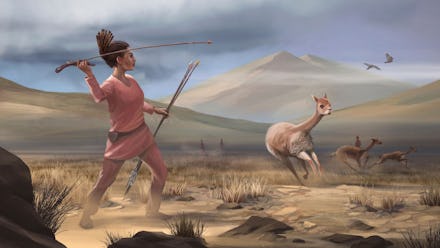Ancient remains prove women have been running shit for at least 9000 years

The skeleton of an ancient woman with hunting gear is challenging longstanding beliefs that men went out to hunt while women simply gathered. The 9,000-year-old remains were found with a fully decked out hunting kit including 20 stone projectiles and a pile of neatly stacked blades. The discovery spurred a team of archaeologists to investigate reports of other burial sites, leading them to theorize there were more gender-equal roles in ancient tribes than modern scholars thought. The archaeologists' study was published in the journal ScienceAdvances on Wednesday.
The lead author, Randall Haas, and his team found the grave of the ancient woman at a Peruvian archaeological site sitting at an altitude of nearly 13,000 feet. When they saw the tool kit next to the body, they thought they uncovered some really cool hot shot hunter guy.
"Everybody was talking about how this was a great chief, a big man," Haas told Science Magazine. But the shape of the bones were different from a man's, and a dental analysis later confirmed they belonged to a young woman estimated to be around 17 to 19 years old. The analysis of her teeth also showed she had a hunter's diet consisting of both meat and plants, leading the team to conclude she was a young hunter.
Their discovery led the crew to search for records of other ancient graves filled with individuals who were buried with hunting tools. Out of 107 sites that were over 8,000 years old, 10 women and 16 men were found with such items.
It's a pretty small sample size, but the authors believe it's enough of a finding to conclude that women took part in big game hunting. Their statistical models provided a possible percentage range of sexes that made up hunting groups, which they estimated were about 30 to 50 percent women. This meant, the team wrote, that "early big-game hunting was likely gender neutral or nearly so."
This is in stark contrast to contemporary societies and modern-day hunter-gatherer groups, which tend to have firm gender roles.
"Labor practices among recent hunter-gatherer societies are highly gendered, which might lead some to believe that sexist inequalities in things like pay or rank are somehow 'natural,'" Haas explained to Science Focus. "But it's now clear that sexual division of labor was fundamentally different — likely more equitable — in our species' deep hunter-gatherer past."
In other words, this discovery provides evidence that female hunters might not be as uncommon as some people think. The authors of the study even called out other "scholars" for bias, writing that they "generally accept that projectile points associated with male burials are hunting tools, but have been less willing to concede that projectile points associated with female burials are hunting tools."
It's something that the entire field needs to work on.
"The message [of the new finding] is that women have always been able to hunt and have in fact hunted," archaeologist Bonnie Pitblado, who did not take part in the study, told Science Magazine. And, frankly, no one should be taken aback by the discovery.
"These women were living high up in the Andes, at 13,000 feet full-time," she added. "If you can do that, surely you can bring down a deer."